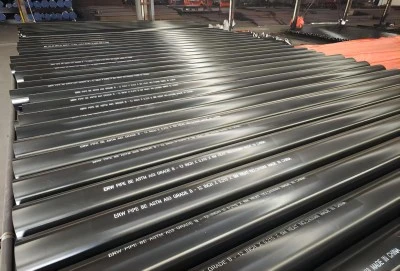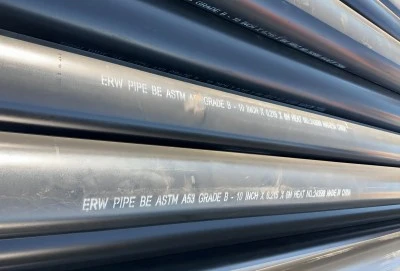In the world of steel pipe manufacturing, two welding processes often come up in discussions: Electric Resistance Welding (ERW) and Electric Fusion Welding (EFW). Both methods are used to produce high-quality steel pipes, but they have distinct characteristics that set them apart. This article will delve into the details of ERW and EFW, comparing their manufacturing processes, weld quality, mechanical properties, and industry standards to help you make an informed decision for your steel pipe needs.
|
|
|
Manufacturing Process & Welding Mechanism
The manufacturing process and welding mechanism are fundamental aspects that differentiate ERW and EFW pipes. Let's examine each method in detail:
Electric Resistance Welded (ERW) Steel Pipes
ERW pipes are manufactured using a continuous process that involves rolling flat steel strips into a cylindrical shape and welding the seam using electrical resistance. The key steps in the ERW process include:
- Coil Preparation: Steel coils are uncoiled and cleaned to remove any surface impurities.
- Edge Milling: The edges of the steel strip are precisely milled to ensure a clean, square edge for welding.
- Forming: The steel strip is gradually formed into a cylindrical shape using a series of rollers.
- Welding: As the edges of the formed cylinder come together, high-frequency electrical current is applied, generating heat through electrical resistance. This heat, combined with pressure from squeeze rolls, creates a forge weld without the need for filler material.
- Heat Treatment: The welded area is often heat-treated to relieve stress and improve the weld's properties.
- Sizing and Straightening: The pipe is sized to precise dimensions and straightened.
- Testing and Inspection: Various quality control measures are implemented, including non-destructive testing of the weld seam.
The ERW process is known for its efficiency and ability to produce pipes with consistent quality at high production rates.
Electric Fusion Welded (EFW) Steel Pipes
EFW, also known as Electric Welded (EW) pipes, uses a slightly different approach:
- Material Preparation: Similar to ERW, steel coils are prepared and cleaned.
- Forming: The steel is formed into a tubular shape.
- Welding: In EFW, an electric arc is used to melt the edges of the pipe and fuse them together. This process often involves the addition of filler material.
- Post-Weld Treatment: The weld area may undergo heat treatment or other processes to enhance its properties.
- Finishing: The pipe is sized, straightened, and prepared for inspection.
EFW pipes are often used for larger diameter pipes and can accommodate thicker wall thicknesses compared to ERW pipes.
While both processes use electricity for welding, the fundamental difference lies in how the heat is generated and applied. ERW uses resistance heating, while EFW uses an electric arc to melt and fuse the metal.
Weld Quality & Mechanical Properties
The quality of the weld and the mechanical properties of the finished pipe are crucial factors in determining the suitability of ERW or EFW pipes for specific applications.
ERW Pipe Weld Quality and Properties
ERW pipes are known for their:
- Consistent Weld Quality: The automated nature of the ERW process results in highly consistent welds along the entire length of the pipe.
- Narrow Heat-Affected Zone (HAZ): The localized heating in ERW creates a very narrow HAZ, which can lead to better overall pipe properties.
- High Production Speeds: ERW allows for faster production rates, making it cost-effective for large volume orders.
- Excellent Straightness: The continuous process typically results in pipes with very good straightness.
- Smooth Interior and Exterior: ERW pipes generally have smoother surfaces, both inside and out, which can be beneficial for certain applications.
However, ERW pipes may have limitations in terms of wall thickness and diameter range compared to some other welding methods.
EFW Pipe Weld Quality and Properties
EFW pipes offer their own set of advantages:
- Versatility in Thickness: EFW can handle a wider range of wall thicknesses, including thicker walls that may be challenging for ERW.
- Larger Diameters: EFW is often used for producing pipes with larger diameters than what is typically possible with ERW.
- Weld Reinforcement: The addition of filler material in EFW can provide extra reinforcement to the weld area.
- Flexibility in Material Selection: EFW can be used with a broader range of steel grades and compositions.
However, EFW pipes may have a wider HAZ and potentially more variability in weld quality compared to ERW pipes.
Both ERW and EFW pipes can meet high standards of mechanical properties, including tensile strength, yield strength, and impact resistance, when properly manufactured. The choice between the two often depends on the specific requirements of the application, such as operating pressure, environmental conditions, and regulatory standards.
Standards & Compliance
Both ERW and EFW pipes are manufactured to meet various international standards and specifications. Understanding these standards is crucial for ensuring that the chosen pipe meets the necessary requirements for its intended application.
Standards for ERW Pipes
ERW pipes are widely used and recognized in many industries. Some of the key standards that govern ERW pipe production include:
- API 5L: This standard from the American Petroleum Institute covers specifications for line pipe used in oil and gas transportation.
- ASTM A53: A standard specification for pipe, steel, black and hot-dipped, zinc-coated, welded and seamless.
- ASTM A500: Covers cold-formed welded and seamless carbon steel structural tubing in rounds and shapes.
- EN 10219: European standard for cold formed welded structural hollow sections of non-alloy and fine grain steels.
- ISO 3183: International standard for steel pipe for pipeline transportation systems in the petroleum and natural gas industries.
These standards specify requirements for chemical composition, mechanical properties, dimensions, and testing procedures for ERW pipes.
Standards for EFW Pipes
EFW pipes, while less common than ERW pipes in some applications, also have their set of governing standards:
- API 5L: This standard also covers EFW pipes, particularly for larger diameters.
- ASTM A671: Specification for electric-fusion-welded steel pipe for atmospheric and lower temperatures.
- ASTM A672: Similar to A671 but for high-pressure service at moderate temperatures.
- EN 10217: European standard that includes specifications for electric welded pipes.
These standards ensure that EFW pipes meet the necessary quality and performance criteria for their intended applications.
Compliance and Quality Assurance
Regardless of the welding method, compliance with these standards typically involves:
- Material Testing: Chemical analysis and mechanical property testing of the base material.
- Non-Destructive Testing: Methods such as ultrasonic testing, eddy current testing, or radiographic testing to inspect the weld quality.
- Hydrostatic Testing: To ensure the pipe can withstand the required pressure without leakage.
- Dimensional Inspection: To verify that the pipes meet the specified dimensions and tolerances.
It's important to note that the choice between ERW and EFW pipes should be based on the specific requirements of the project, including the applicable standards and specifications. In many cases, both types of pipes can meet the same standards, and the decision may come down to factors such as availability, cost, and specific project requirements.
How to choose?
In the debate of ERW vs. EFW pipes, there is no clear-cut winner. Both methods have their strengths and are suited for different applications. ERW pipes excel in high-volume production of smaller to medium-sized pipes with consistent weld quality, while EFW pipes offer versatility in terms of wall thickness and diameter range.
The choice between ERW and EFW ultimately depends on factors such as:
- The specific application requirements
- Pipe diameter and wall thickness needed
- Production volume
- Cost considerations
- Applicable industry standards
For many applications, particularly in the oil and gas, construction, and water transportation industries, ERW pipes offer an excellent combination of quality, efficiency, and cost-effectiveness. If you're in search of high-quality electric resistance welded steel pipes for your business, Longma Group is here to meet your needs. We specialize in producing ERW steel pipes that comply with a wide range of standards, including ASTM A53 Gr.B, API 5L (Gr.B, X42, X46, X52, X56, X60, X65, X70, X80 PSL1 and PSL2), ASTM A252, ASTM A500, AS/NZS 1163, AS/NZS1074, EN10219, and EN10217.
Our ERW pipes feature an outer diameter range of 1/4"-20" (13.7mm-508mm), wall thickness from SCH10 to SCH160 (6.35mm-59.54mm), and lengths from 6m to 18m. We offer both Beveled Ends (BE) and Plain Ends (PE) options to suit your specific requirements. With our state-of-the-art manufacturing facilities and stringent quality control processes, we ensure that every pipe meets the highest standards of quality and performance.
Don't miss the opportunity to enhance your projects with our excellent steel pipes. Contact us nowat info@longma-group.com to explore how Longma Group can be your reliable partner in steel pipe solutions. Our team of experts is ready to assist you in selecting the right pipes for your specific needs and ensuring smooth delivery to your project site.














